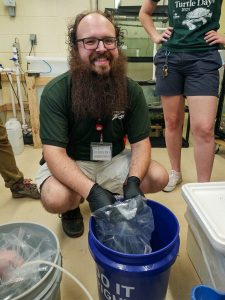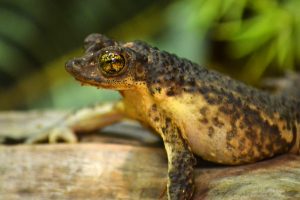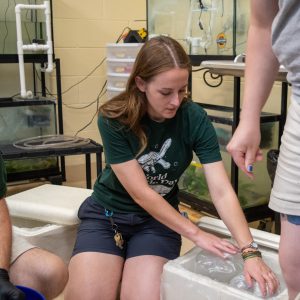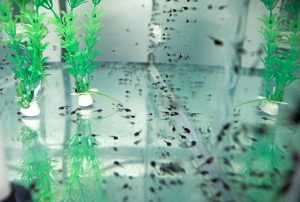 Potter Park Zoo recently took part in a significant conservation effort by sending 2000 Puerto Rican crested toad tadpoles to Puerto Rico. This initiative aims to reestablish the wild population of this endangered species, and it is carried out by the Puerto Rican Crested Toad Conservancy (PRCTC), a collaborative effort involving zoos, individuals, and organizations dedicated to the long-term survival of the Puerto Rican crested toad in its natural habitat.
Potter Park Zoo recently took part in a significant conservation effort by sending 2000 Puerto Rican crested toad tadpoles to Puerto Rico. This initiative aims to reestablish the wild population of this endangered species, and it is carried out by the Puerto Rican Crested Toad Conservancy (PRCTC), a collaborative effort involving zoos, individuals, and organizations dedicated to the long-term survival of the Puerto Rican crested toad in its natural habitat.
The Puerto Rican crested toad, scientifically known as the Peltophrynee lemur, was believed to be extinct until a small population was discovered in the northern part of Puerto Rico in 1967. It is the only toad species native to Puerto Rico and is currently classified as Critically Endangered on the IUCN Red List due to factors such as habitat loss and competition from invasive species like the marine toad.
 In 1984, the Puerto Rican crested toad became the first amphibian to receive Species Survival Plan (SSP) status within the Association of Zoos and Aquariums. The SSP Program involves a captive breeding program aimed at increasing the toad population and implementing recovery goals. These goals include protecting and restoring existing habitats, implementing island-wide educational programs, and creating new breeding ponds. As part of the SSP breeding program, Potter Park Zoo has sent tens of thousands of tadpoles to Puerto Rico.
In 1984, the Puerto Rican crested toad became the first amphibian to receive Species Survival Plan (SSP) status within the Association of Zoos and Aquariums. The SSP Program involves a captive breeding program aimed at increasing the toad population and implementing recovery goals. These goals include protecting and restoring existing habitats, implementing island-wide educational programs, and creating new breeding ponds. As part of the SSP breeding program, Potter Park Zoo has sent tens of thousands of tadpoles to Puerto Rico.
 Breeding Puerto Rican crested toads in human care requires recreating the specific environmental conditions of Puerto Rico’s spring and fall rainy seasons. To achieve this, the zoo team cools the toads to 66 degrees Fahrenheit for one month to stimulate gamete development. During this period, the toads enter a state of inactivity called torpor and do not eat. After a month, they are warmed up to 82 degrees Fahrenheit and resume feeding. To prevent the spread of disease, the toads receive daily anti-fungal baths for a week before the breeding event.
Breeding Puerto Rican crested toads in human care requires recreating the specific environmental conditions of Puerto Rico’s spring and fall rainy seasons. To achieve this, the zoo team cools the toads to 66 degrees Fahrenheit for one month to stimulate gamete development. During this period, the toads enter a state of inactivity called torpor and do not eat. After a month, they are warmed up to 82 degrees Fahrenheit and resume feeding. To prevent the spread of disease, the toads receive daily anti-fungal baths for a week before the breeding event.
The pairing of toads for breeding is recommended by the SSP coordinator. This year, Potter Park Zoo was asked to breed two pairs of toads. The breeding tanks are equipped with rain bars, and the sounds of Puerto Rican crested toad calls are played continuously. Once the eggs are laid, the adult toads are removed from the tanks and returned to their holding tanks. The eggs develop rapidly, and the tadpoles hatch after only 24 hours. Unlike adult toads, tadpoles are herbivorous and feed on algae and other plant material. They stay at Potter Park Zoo for around one week, allowing them to grow before being shipped to Puerto Rico for release.
 Around 2-3 weeks after hatching, the Puerto Rican crested toad tadpoles undergo metamorphosis and transform into young toads. This quick transformation is crucial because these toads breed in temporary ponds in the wild, and tadpoles need to become toads before the ponds dry up. However, it takes several years for them to reach their adult size of 2-3 inches. Visitors to the zoo can observe our Puerto Rican crested toads on exhibit in the reptile building!
Around 2-3 weeks after hatching, the Puerto Rican crested toad tadpoles undergo metamorphosis and transform into young toads. This quick transformation is crucial because these toads breed in temporary ponds in the wild, and tadpoles need to become toads before the ponds dry up. However, it takes several years for them to reach their adult size of 2-3 inches. Visitors to the zoo can observe our Puerto Rican crested toads on exhibit in the reptile building!
Potter Park Zoo is home to nearly 300 animals, including critically endangered black rhinos, endangered red pandas, Massasauga rattlesnakes, and spider monkeys. The zoo is open 364 days a year, providing visitors with a unique opportunity to learn about and appreciate the diverse wildlife of our planet year-round. To learn more about Potter Park Zoo and the incredible animals in their care, visit: potterparkzoo.org.



